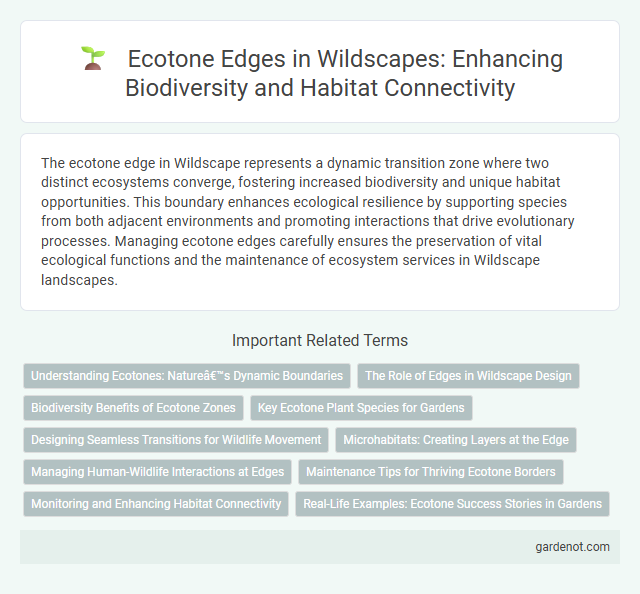The ecotone edge in Wildscape represents a dynamic transition zone where two distinct ecosystems converge, fostering increased biodiversity and unique habitat opportunities. This boundary enhances ecological resilience by supporting species from both adjacent environments and promoting interactions that drive evolutionary processes. Managing ecotone edges carefully ensures the preservation of vital ecological functions and the maintenance of ecosystem services in Wildscape landscapes.
Understanding Ecotones: Nature’s Dynamic Boundaries
Ecotones are transitional zones where two distinct ecosystems meet and interact, creating unique environmental conditions that support high biodiversity and species richness. These natural boundaries foster increased ecological interactions and nutrient exchange, making them critical for habitat diversity and resilience. Understanding ecotones reveals their role in ecosystem stability, climate adaptation, and conservation strategies within wildscape management.
The Role of Edges in Wildscape Design
Edges in wildscape design function as ecotones, transitional zones where two distinct habitats meet, fostering increased biodiversity and ecological interactions. These edge areas support a variety of plant and animal species by providing unique microclimates and abundant resources, enhancing habitat complexity. Thoughtful incorporation of ecotone edges maximizes wildlife corridors and promotes ecosystem resilience within the wildscape environment.
Biodiversity Benefits of Ecotone Zones
Ecotone zones function as critical biodiversity hotspots by merging two distinct ecosystems, thereby supporting a greater variety of species compared to individual habitats alone. These transitional areas provide unique microclimates and diverse resources that enhance species richness and ecological interactions. Increased biodiversity in wildscapes boosts ecosystem resilience, promoting natural pest control, pollination, and nutrient cycling essential for environmental stability.
Key Ecotone Plant Species for Gardens
Key ecotone plant species for gardens in Wildscape include native shrubs like Cornus sericea and Salix spp., which provide critical habitat transition zones between forest and meadow ecosystems. These species enhance biodiversity by supporting pollinators and bird populations while improving soil stability along edge habitats. Incorporating ecotone species such as Asclepias tuberosa and Rudbeckia hirta promotes a resilient garden ecosystem that mirrors natural edge dynamics.
Designing Seamless Transitions for Wildlife Movement
Ecotone edges serve as critical transitional zones between distinct habitats, supporting diverse species by providing varied resources and shelter. Designing seamless ecotone edges enhances wildlife movement by minimizing barriers and promoting connectivity across fragmented landscapes. Strategic placement of vegetation layers and natural corridors facilitates species migration, genetic exchange, and ecosystem resilience within wildscapes.
Microhabitats: Creating Layers at the Edge
Ecotone edges in wildscape design facilitate the formation of diverse microhabitats by creating layered transitions between distinct ecosystems, such as forests and grasslands. These layered zones support increased biodiversity by offering varied niches for insects, birds, and small mammals, enhancing ecosystem resilience. Structuring vegetation in vertical and horizontal gradients maximizes sunlight exposure and soil moisture variability, crucial for sustaining specialist species in conservation landscapes.
Managing Human-Wildlife Interactions at Edges
Ecotone edges represent transitional zones where wildlife habitats meet human activity, creating critical areas for managing interactions to reduce conflict and promote biodiversity. Effective strategies include habitat design that minimizes attractants, installation of wildlife corridors, and community education on coexistence practices. Monitoring edge habitats with remote sensing and field surveys ensures early detection of human-wildlife conflicts, optimizing adaptive management efforts.
Maintenance Tips for Thriving Ecotone Borders
Maintaining thriving ecotone borders in Wildscape landscapes requires regular monitoring of soil moisture and nutrient levels to support diverse plant species. Select native plants with complementary growth habits to reduce competition and promote mutual benefits along the ecotone edge. Implement seasonal pruning and controlled mowing to prevent invasive species from encroaching and ensure optimal habitat structure for wildlife diversity.
Monitoring and Enhancing Habitat Connectivity
Ecotone edges serve as critical transitional zones that enhance habitat connectivity by facilitating species movement and genetic exchange between distinct ecosystems. Monitoring these edges using remote sensing and biodiversity surveys provides essential data on species distribution patterns and ecological health. Implementing restoration strategies at ecotone edges can improve landscape permeability, supporting resilient wildlife populations and promoting overall ecosystem stability.
Real-Life Examples: Ecotone Success Stories in Gardens
Ecotone edges in gardens create rich biodiversity by blending distinct ecosystems, fostering unique microhabitats that support pollinators, birds, and beneficial insects. Successful examples include community gardens in Portland, Oregon, where native plant buffers between lawn and woodland areas have increased local wildlife sightings by 40%. These ecotones enhance soil health and water retention, proving vital for sustainable urban gardening practices.
Ecotone edge Infographic

 gardenot.com
gardenot.com